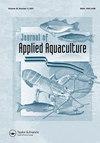Effect of dietary Andrographis paniculata leaf extract on growth, immunity, and disease resistance against Aeromonas hydrophila in Pangasianodon hypopthalmus
IF 0.8
Q3 FISHERIES
引用次数: 13
Abstract
ABSTRACT Aeromonas hydrophila severely hampers the farmed catfish production. A 60-day feeding trial was conducted to study the effect of Andrographis paniculata leaf extract on growth, immunomodulation, and disease outbreak against A. hydrophila in Pangasianodon hypophthalmus. A total of 180 juveniles of P. hypophthalmus (avg. wt. 123.33 ± 1.8 g) were distributed randomly in four groups following a completely randomized design in triplicate. Four experimental diets—C (no extract), T1 (1%), T2 (2%), and T3 (4%)—were prepared and fed twice daily. Growth metrics were calculated after 45 days and challenged with A. hydrophila. Relative percentage survival (RPS) was recorded over 15 days postchallenge. Results indicated that A. paniculata extract has a positive effect on hematobiochemical parameters and immune response. The highest (P < 0.05) pre- and postchallenge serum lysozyme activity, respiratory burst activity, and globulin level were found in the T2 group and lowest in the T0 group. Significantly (P < 0.05) higher percentage weight gain and SGR and lowest FCR were found in the T2 group than in the other groups. RPS was highest (P < 0.05) in the T2 group, followed by the T1 and T3 groups, compared to the control. Results suggest that A. paniculata leaf extract at a level of 2% could improve growth, immunity, and disease resistance against A. hydrophila by enhancing innate immunity in P. hypophthalmus.日粮中添加穿心莲叶提取物对下眼穿心莲生长、免疫及对嗜水气单胞菌抗病性的影响
嗜水气单胞菌严重影响养殖鲶鱼的生产。通过60 d的饲养试验,研究穿心莲叶提取物对低眼穿心莲生长、免疫调节和嗜水蚤发病的影响。采用完全随机设计,将180只低眼棘球绦虫(平均体重123.33±1.8 g)随机分为4组。配制4种试验饲粮c(不含提取物)、T1(1%)、T2(2%)和T3(4%),每天饲喂2次。45天后计算生长指标,并用嗜水单胞菌攻毒。记录攻毒后15天的相对存活率(RPS)。结果表明,菟丝子提取物对小鼠血液生化指标和免疫应答均有积极影响。攻毒前和攻毒后血清溶菌酶活性、呼吸爆发活性和球蛋白水平均以T2组最高(P < 0.05), T0组最低。T2组的增重率和SGR显著高于其他各组(P < 0.05), FCR最低(P < 0.05)。与对照组相比,T2组RPS最高(P < 0.05), T1和T3组次之。结果表明,2%浓度的金针叶提取物可通过增强眼小蠊的先天免疫来促进其生长、免疫和对嗜水小蠊的抗病能力。
本文章由计算机程序翻译,如有差异,请以英文原文为准。
求助全文
约1分钟内获得全文
求助全文
来源期刊

Journal of Applied Aquaculture
Environmental Science-Ecology
CiteScore
3.20
自引率
0.00%
发文量
38
期刊介绍:
The Journal of Applied Aquaculture is a platform for the sharing of practical information needed by researchers to meet the needs of investors, farm managers, extension agents and policy makers working to adapt aquaculture theory to achieve economic and food security objectives in the real world. The journal emphasizes multi-disciplinary research and case studies that propose financially and logistically viable solutions to observable problems.
 求助内容:
求助内容: 应助结果提醒方式:
应助结果提醒方式:


